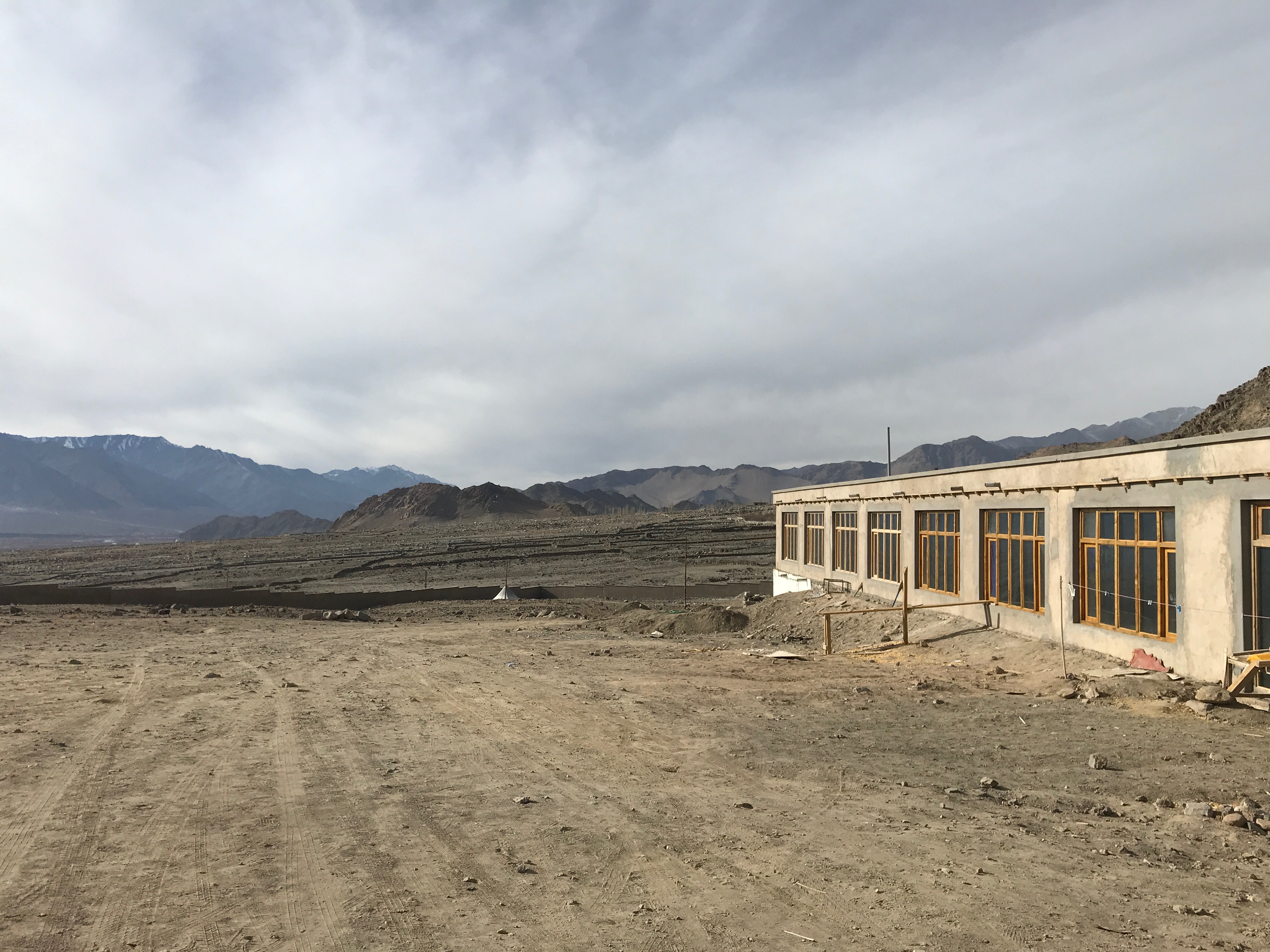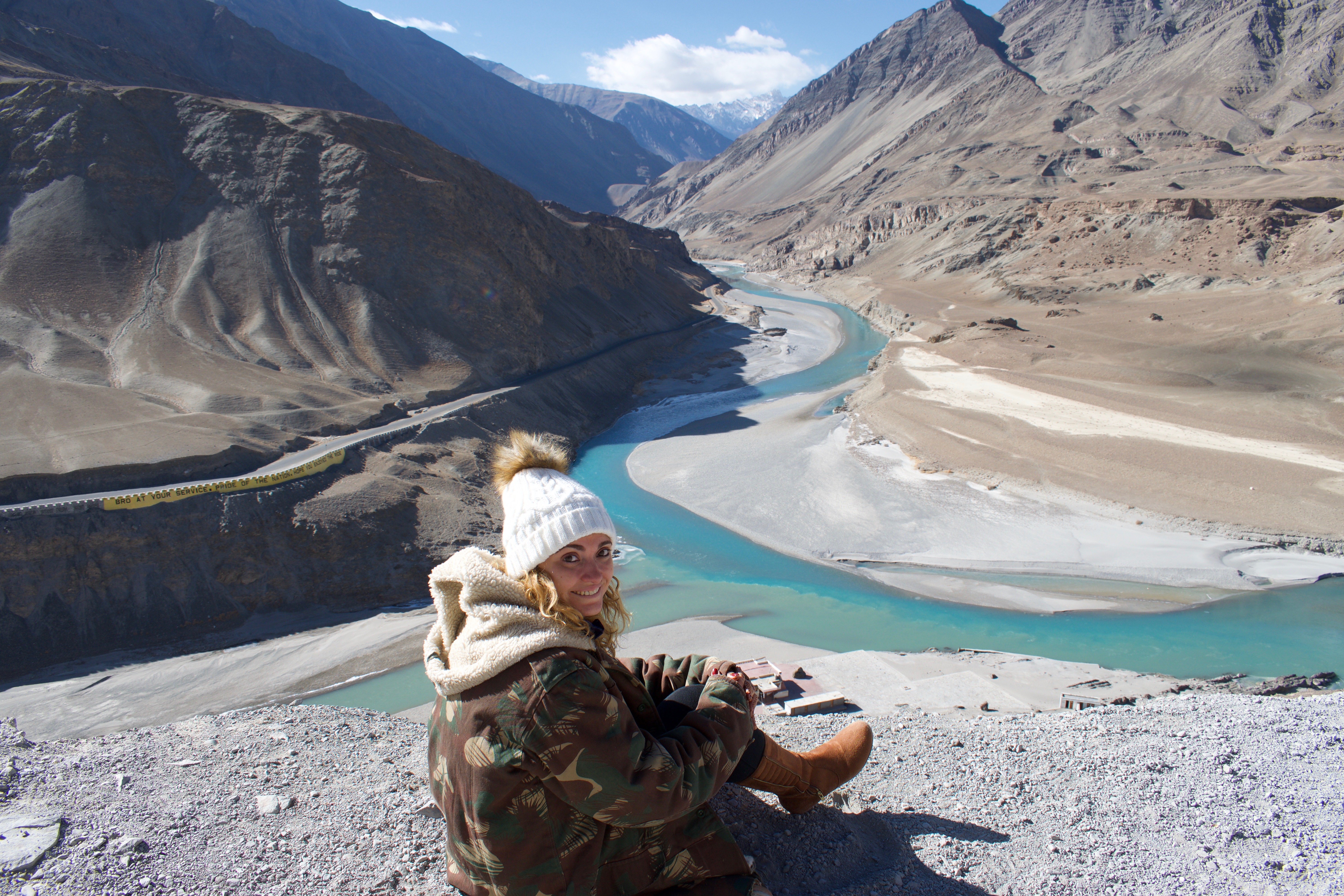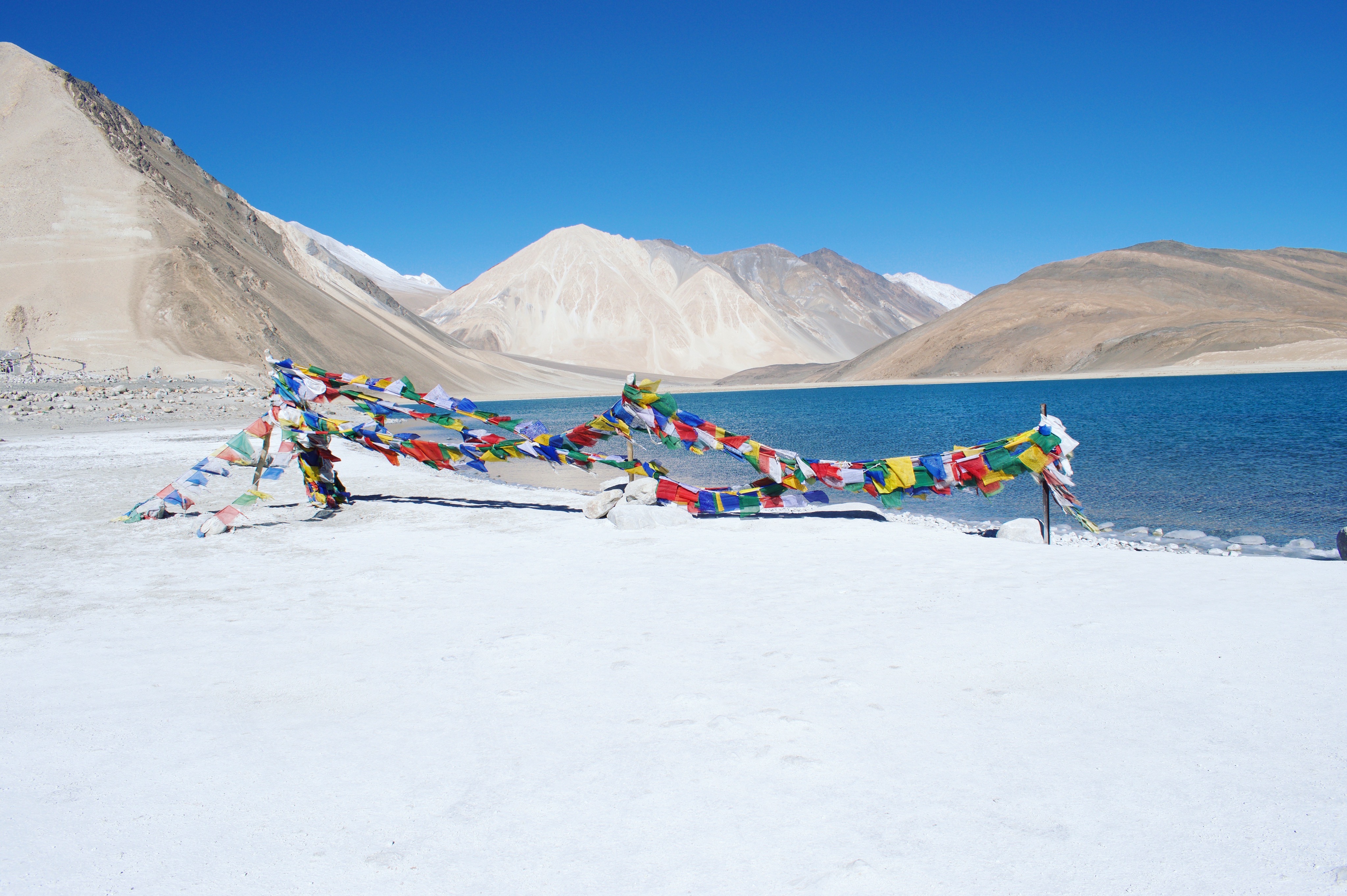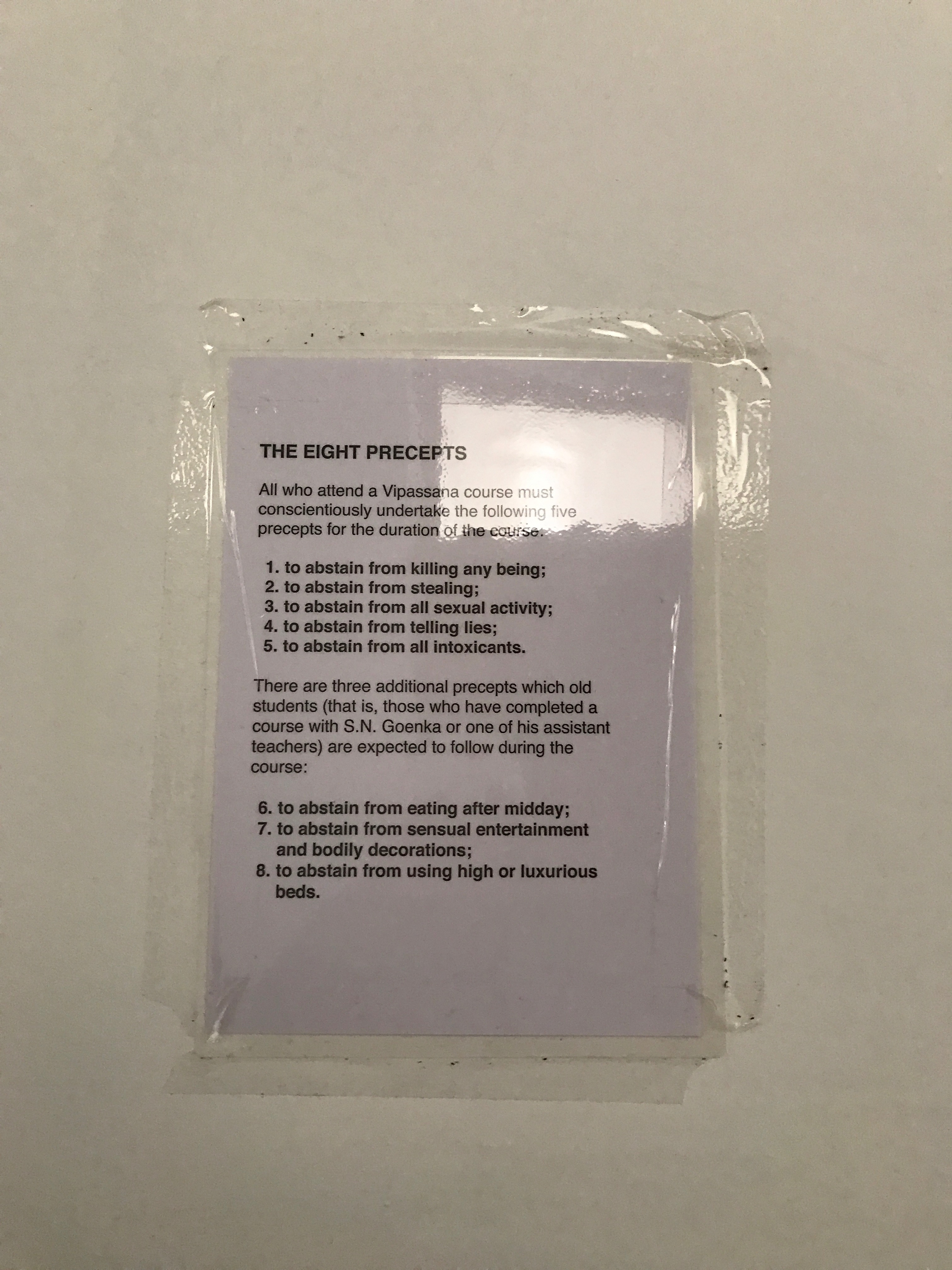My Vipassana Meditation Course Experience in Leh, Ladakh

Ever since a friend in India mentioned the 10-day Vipassana Meditation Course to me a year ago, I’ve kept in in the back of my mind. But I was waiting for the right time to do it. I wanted to have a strong body and mind that was open to what the course would offer.
And so it happened that the right time had come. After doing a 7-day detox / fasting program in Thailand, resting a bit and feeling refreshed, finishing up some amazing work in India, and traveling, I just knew that this was the exact right time.
The Gift
First, I want to say that in today’s world, it is super hard to get away for 10 full days from all your daily responsibilities. The 10-day course (12 days if you count the day you arrive and leave) involves complete segregation from the outside world. No news, no Internet, no phone calls, no reading, no writing, no speaking…
It’s a big sacrifice to make for most people. I don’t have my own family, but I definitely felt a little guilt over abandoning my team in the midst of a big project. I can’t imagine the sacrifice you need to make if you do have a spouse and especially children.
But this is the biggest gift you can give yourself. The gift of a different life. A better life for you and everyone around you.
What is Vipassana?
I’ll admit - I did not do much research into what this meditation course was all about. I figured the less I knew, the more open-minded I’d be. If you’re the same way, feel free to stop reading this blog post!
Turns out, Vipassana is an ancient meditation technique that was passed down from Buddha himself! I’m sure you can Google it for more information. I’ll describe it here as I understand it.
The technique is simple in theory - just feel subtle (and gross) sensations on every part of your body. The theory is that you get stimuli via the senses from your surroundings. The stimuli create sensations on your body. You react to these sensations by either craving (to pleasurable sensations) or aversion (to painful / unpleasant sensations).
The goal is to be free from this cycle of craving / aversion response, which only makes you a slave and creates misery. By observing the sensations before your mind translates them into craving (pleasure) or aversion (pain), you can have more control over your response (and your life in the long term). You learn that each sensation is fleeting. The only pain that stays is the one you create in your mind.
As a psychology major, this theory makes a lot of sense to me. One big experiment that comes to mind is with Pavlov’s dog - where the famous psychologist trained the dog to salivate to a stimulus associated with food (e.g. a bell that rang every time food came). The bell caused the same pleasant sensations in the dog as the food itself, and it responded by salivating even when food was not present. Just like the dog, we, humans, have built-in responses to certain stimuli that we don’t think about.
This meditation is meant to make you more present and to evaluate your responses in the present moment, instead of responding automatically based on past experience (which is no longer the truth).
Vipassana means “to see things as they really are” - you are training to observe the truth in every moment.
The Location
Of course, as it happens, the right time for you might not be the best time in other ways… Although there are Vipassana courses all over the world now, my friend recommended doing the course in Leh, Ladakh - the most incredible high-altitude dessert in the Himalayas:

I’ve wanted to visit Leh anyway, but end-of-November / beginning-of-December is a bad time to visit… it is COLD!!! Most normal people visit in the late spring and summer. But when it’s the right time for the mind, it is the right time… And no real regrets here. As you can tell from the above photo, Leh is one of the most beautiful places in the world no matter the season…

Leh is located at 3,500 m (11,482.94 ft) above sea level. That means it’s wise to get there early to get used to the altitude. I’ve never been at that altitude (I don’t think), so I didn’t know what to expect from my body.
We got there five days before the start of the meditation course via a flight from Delhi to acclimate and do some touring. The day of arrival, I felt lightheaded and stayed in the hotel room bed, drinking LOTS of water. But after that, I felt fine luckily.
After a lot of great touring, it was time for the meditation course to begin…
The Facilities
Before I continue - I want to clarify that the Vipassana course is free. You can donate as much as you want at the end of the course.
This is a good thing - anyone can join. But also a bad thing for those who are used to Western-style comforts in life… This is NOT a 5-star hotel… In fact, it is more like a hostel… And there is no way to upgrade to a nicer room or anything…

As you can see - the room is the simplest you can imagine. Just 3 beds (one bed not pictured). Yes - that means that you will like have to share this tiny room…
Luckily, only 5 / 26 women showed up to the meditation course I signed up for, so I got a full room to myself 😅 I personally would have been very uncomfortable if I had to share a room. That is one perk of doing this meditation course off-season in a very remote location…
Did I mention this is not a 5-star hotel? Or any type of hotel? The bed was super hard for me - my side hurt (like it was bruised) when I woke up in the morning. Oh, and there was no heating in the facility. I managed by filling up my water bottle with boiling hot water before bed, and sleeping with it under the 3 blankets that I took from the other beds.
You’re supposed to bring your own towel (I didn’t know, so I ended up using my t-shirts as towels) and even sheets (luckily they did have some sheets). I brought my own toilet paper, but I ran out - they were able to give me one small roll, but had a hard time finding another one when I ran out again! Speaking of toilets, there were 2 Western-style toilets. The rest were Indian-style…
I assumed before arriving that there wouldn’t be hot water, so on the first morning there, I washed with cold water out of a bucket. Did I mention there is no real shower? Later that day, the teacher’s assistant showed us how to get hot water from this amazing solar-powered device located outside the bathroom - just pour water in, and hot water comes out into a bucket that you can use for washing.
The other buildings on the small campus included the men’s dorm, a kitchen with dining halls (one for men, one for women), and the meditation center. For food, you got assigned a set of utensils - an Indian-style steel plate, a cup, and a spoon, and you were responsible for washing it (with cold water) after every meal.
I know this all sounds horrible. But honestly, I expected a lot of it, so it didn’t bother me overall. I spent most of my free time roaming around outside enjoying the spectacular view:

I’m sure other Vipassana facilities around the world are more convenient and modern (I heard great things about the London one), but I don’t think you can beat the breathtaking sunrises and sunsets in Leh that I got to witness every day.
The Rules
Being in a Vipassana course is like being in prison. The rules are super strict, and they’re watching you! Yes - I did grow some serious fear and paranoia from some of the interactions with the teacher and teacher’s assistant…
Segregation
For one, there is a segregation of men and women. Each one is confined to their side of campus. As I mentioned, men and women each have their own dorms and even dining halls. In the meditation hall, men and women have their own separate entrances. Men sit on one side, and women on the other.
Course Boundaries
You have to stay within the course boundaries, which is a pretty small area overall. As you might have guessed, men and women have different boundaries, which do not overlap.
On the very first day, I crossed the boundary to explore a cool rock structure that someone built because I didn’t fully understand where the boundary was… I got into a lot of trouble from the teacher, who made it clear that people in other Vipassana courses have been kicked out for crossing the boundary (hence the inception of my fear and paranoia during the course…).
Noble Silence
Another HUGE rule is Noble Silence. You’re not allowed to talk or communicate in any way with other students. Not even with eye contact or gestures or hand-written notes. You are allowed to ask questions from the teacher and teacher’s assistant.
This was easy for me - I came to the course for myself, not to communicate with others. Did I mention I’m an introvert? This rule might be harder for extroverts.
Actually, on Day 10 of the course, we were supposed to break the silence and start talking… which I really dreaded. During the first non-silent break, I just followed my normal routine of walking around without talking to anyone, but they came over to talk to me. They ended up all being awesome, and I couldn’t stop talking to everyone until the next morning when we were to leave…
The 5 Precepts
As a first time student, I was to follow five rules:

I wasn’t planning on killing anyone, so this was easy… But seriously, the course keeps you so busy and non-talking (no lying), that you don’t really have a chance to commit any of these…
The Food
I assumed food would be the same rice gruel every day, but to my surprise, it was some of the best food I’ve had in India! Every day something different - Indian vegetarian food that was perfectly spiced to taste rich, but not burn-your-mouth spicy. Seriously, sooooo delicious!! And made with so much love. You can taste it! I cannot thank the chefs enough.
I’ll get to it later, but the course experience was pretty miserable for me. Having this amazing food was a big highlight of the day.
But of course there is a catch… no dinner! That’s right. Dinner is basically a piece of fruit and some dry cereal. For me, this wasn’t a problem. I actually either don’t eat dinner or eat a super light dinner most of the time as per my Ayurvedic diet recommendation. But I just wanted to mention it for those who are used to a real big dinner. You might have problems here…
The Schedule
Now onto the meaty part of the course… the schedule is pretty intense. From 5:00 am to 9:00 pm every day for 10 days, you’re following the ring of a bell (yes, they even train you like Pavlov’s dogs!). You’re eating, having a short break, but otherwise meditating:

I usually wake up around 4:00 am, and go to sleep at 8:00 pm, so waking up was not hard for me. I did get super tired by 9:00 pm though!
I was also the one person who showered first thing in the morning at 5:00 am while everyone else was still laying in bed until the 5:30 am meditation. Since it was a cold place, I knew that I hold the most heat in the morning, so it was the only time of day when I could tolerate the washing in the cold (the hot water helped, but washing out of a bucket with hot water in a cold environment is not pleasant overall!). It made me feel great to start the first meditation all awake and clean!
At the end of each day, there was a video lecture from the Vipassana Meditation program founder S.N. Goenka. These lectures were AMAZING! It was like he knew exactly what we were going through each day, and addressed all the issues. He’s an amazing lecturer and storyteller. It was probably the one time each day that I actually laughed.
The lectures really motivated me to do better on the last meditation of the day, which, in-turn, helped me start off strong the next morning.
The Misery
Before coming to this course, the longest I’ve meditated for was 20 minutes. And that was several years back… I usually gave up after 10 minutes or so, because I wasn’t comfortable sitting. I get back pain!
But in this course, every day for 10 days - you have to meditate literary ALL DAY LONG in one-hour increments. There will be a 5 minute break, then back for another hour of meditation, then another, and then more meditation!
It was horrible! During the first few days, I had a lot of back pain and my right leg would fall asleep. On Day 2 or 3, the teacher allowed me to lean against the wall. That helped a lot. After a few days, my back pain has stopped. I was excited to be able to sit straight, but it didn’t fully help… other discomforts came up.
Furthermore, the meditation hall was super depressing. There was this gorgeous place and nature outside, but we were forced to sit in this dark meditation hall all day. So much sitting! It didn’t feel healthy (until I realized I probably sit that much every day in normal life…).
Oh, and since it was cold and most people have come from the hot climates of India, everyone was slightly sick. People were coughing, sneezing, belching, moving around. It was hard to concentrate with all the distractions.
On top of that, the teacher and teacher’s assistant would watch you and lecture you if you did something wrong. Or follow you and ask you where you’re going if you needed to go to the bathroom during a meditation sitting. It felt like a horrible prison.
Running Away
There was a woman who quit by Day 3. I think she had the right idea…
I’m usually the person who would have quit this type of miserable situation, but in my mind, I was committed. Remember how I mentioned it was the right time for me to do this meditation? I knew I had to stick through it.
But the thing that kept me going was the belief that it would get easier. It was only Day 2, it’s just the beginning. Surely, it will get easier.
Well, it didn’t! Every single day was a struggle to survive and get through it. But even after 5 days, I still believed that it would get easier… Some days later, it got easier in the morning, but I would be back to my misery by night. Even up to the last minute on campus, I could feel the misery, the need to run away.
Even when I did consider running away, it wasn’t very practical. I used up all my credit card points for my pre-meditation hotel stay in Leh, and it was too expensive to book the hotel for another 5 days to wait for my flight.
Quitting was not an option. If you do this course - make sure that’s the case. It’s going to be hard and miserable, so put in whatever stops you need to make sure you have no option but to stay.
The Breakthrough
As I already mentioned, I was miserable every day. I was either bothered by the way the course was run, by myself for having such a painful body, or by someone else - either one of the students who was moving or coughing a lot during the meditation or something the teacher or teacher’s assistant said to me.
But on the 9th day, in the evening, I was walking around in a circle after dinner when I was suddenly able to detach from the situation. I saw the whole course as a funny show. Something that would befit a book - a psychological thriller perhaps? Normal people put into a prison of their own minds. Or something like the Truman Show - where everything and everyone was planted in this situation just for my misery.
For example, there was this small artisan carpet in the meditation hall. It was green with a pattern of yellow / orange triangles. It looked fine if you just glance at it. But during the impossibly long hours of meditation, I would sometimes open my eyes and look at it closely to pass the time. It was a horrible artisan work! Every single triangle was misaligned in a different way. But suddenly, it was funny. They even placed this carpet there to mess with the OCD people in the room!
The point is, I realized that the entire environment was made-up and very temporary. I’m actually usually very good at detaching myself from such situations. But this was different. There were no distractions to turn to - books, Netflix, music, even speaking to others about it. And this was super long-term - 10 days! So I couldn’t detach myself until that moment.
I did very well in my after-dinner meditation that night. Not taking everything so seriously was the key.
The Final Act
I’ve always wanted to meditate. I know the many benefits intellectually. But I could never stick to it.
This 10-day Vipassana Meditation course is a very brute-force approach to make you meditate. There is no mercy there that you would give yourself (that I gave myself) when you try to meditate on your own.
The truth is, meditation is HARD! And it doesn’t get any easier. This particular meditation, the one passed down from Buddha, is extra hard and unpleasant. At least in other meditations I tried, I got some clarity of mind and pleasant results. Here, there is nothing pleasant about it. It’s about surviving it. You can’t check-out during it - you have to remain very aware and conscious - your brain is ON the whole time!
But it does make a lot of sense to me, and I believe that the benefits will come.
It’s been about two weeks since the course ended, and I’ve continued to meditate for at least an hour every day. My goal is to meditate for one hour in the morning, and one hour in the evening. I am confident that I’ll get there. For now, I’m happy that I can sit still for one hour.
Of course, outside the course, it is harder to meditate. I haven’t been able to reach the same level of meditation success that I have in the course. But I’m ok with it. I’ll get there again. I got a taste of what is possible, and it’s only a matter of time, patience, and consistent practice to get back there.
It is recommended to do the Vipassana course multiple times. As I was walking in a circle on that 9th day in misery, I thought that the only way I would do the course again was when I found the whole thing funny. At the time, I didn’t think I could get past my misery. But even just a few minutes later, I did find the whole situation funny in my detached revelation.
So who knows, I might do it again someday. For now, I’m happy I survived the one course. This is definitely not for the weak of mind. I will continue to strengthen my own mind through meditation.
Many friends have asked me if they should do this course. All I have to say is that it’s not a nice beach vacation. Meditating in an exotic place like Leh sounds calm and serene and wonderful. But in reality it is stormy and messy. If you’re ready to deal with the mess that is your mind, definitely do it!